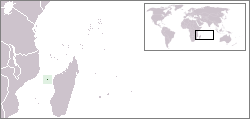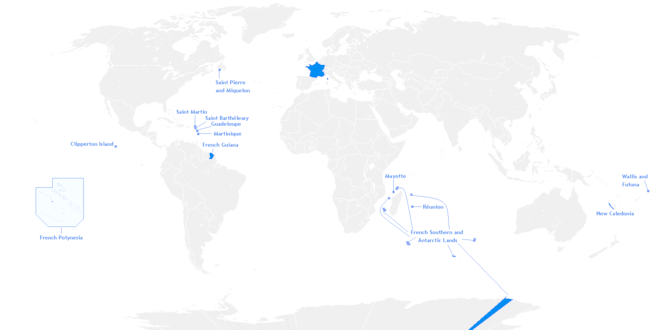Juan de Nova Island
Juan de Nova Island (French: Île Juan de Nova, pronounced [il ʒɥɑ̃ də nɔva]) is a French tropical island in the narrowest part of the Mozambique Channel, about one-third of the way between Madagascar and Mozambique. It is a low, flat island, 4.8 square kilometres (1.9 sq mi) in size.
| Native name: | |
|---|---|
.jpg) | |
 | |
| Etymology | João da Nova |
| Geography | |
| Location | Mozambique Channel |
| Coordinates | 17°03′16″S 42°43′30″E |
| Area | 4.8 km2 (1.9 sq mi) |
| Length | 6 km (3.7 mi) |
| Width | 1.6 km (1 mi) |
| Coastline | 12.3 km (7.64 mi) |
| Administration | |
| Territory | Southern and Antarctic Lands |
| District | Scattered Islands |
| Demographics | |
| Population | 15 (Military) (2019) |
| Additional information | |
| Time zone | |
Anchorage is possible off the northeast of the island which also has a 1,300-metre (4,300 ft) airstrip. Administratively, the island is one of the Scattered islands in the Indian Ocean, a district of the French Southern and Antarctic Lands. The island is garrisoned by French troops from Réunion and has a weather station.[1]
Description
Juan de Nova, about six kilometres (3.7 mi) long and 1.6 kilometres (1 mi) at its widest, is a nature reserve surrounded by reefs which enclose an area—not a true lagoon like in an atoll—of roughly 40 square kilometres (15 sq mi). Forests, mainly of Casuarinaceae, cover about half the island. Sea turtles nest on the beaches around the island.
History
João da Nova, a Galician admiral in the service of Portugal, came across the island in 1501.The island is named for him, with the Spanish spelling.
The island had never been inhabited when it became a possession of France in 1897.[2] Guano deposits were exploited from the start of the 20th century until 1970.
In 1921, France transferred the administration of Juan de Nova from Paris to Tananarive in its colony of Madagascar and Dependencies.
The island was abandoned during World War II, and was visited by German submariners. Installations, including a hangar, rail lines, houses and a jetty are in ruins.
Before the independence of Madagascar, France transferred the administration to Saint-Pierre on Réunion. Madagascar became independent in 1960, and claims sovereignty over the island since 1972.
Wrecks
The island lies on the sea route between South Africa and the northern tip of Madagascar. It is affected by strong currents and has become the site of numerous wrecks. Most visible are the remains of the SS Tottenham which ran onto the southern fringing reef in 1911.
Geology
Important Bird Area
The island has been identified as an Important Bird Area by BirdLife International because it supports a very large colony of sooty terns, with up to 100,000 breeding pairs. It also has a much smaller colony of greater crested terns – with at least 50 breeding pairs recorded in 1994. Of at least seven species of land birds present, most are probably introduced.[3]
Climate
| Climate data for Juan de Nova Island | |||||||||||||
|---|---|---|---|---|---|---|---|---|---|---|---|---|---|
| Month | Jan | Feb | Mar | Apr | May | Jun | Jul | Aug | Sep | Oct | Nov | Dec | Year |
| Record high °C (°F) | 34 (93) |
33 (91) |
33 (91) |
33 (91) |
33 (91) |
33 (91) |
32 (90) |
33 (91) |
33 (91) |
32 (90) |
34 (93) |
35 (95) |
35 (95) |
| Average high °C (°F) | 30.1 (86.2) |
30.0 (86.0) |
30.4 (86.7) |
30.2 (86.4) |
28.9 (84.0) |
27.4 (81.3) |
26.8 (80.2) |
26.9 (80.4) |
27.7 (81.9) |
28.8 (83.8) |
29.9 (85.8) |
30.4 (86.7) |
28.9 (84.0) |
| Daily mean °C (°F) | 28.3 (82.9) |
28.2 (82.8) |
28.6 (83.5) |
28.3 (82.9) |
27.2 (81.0) |
25.7 (78.3) |
24.9 (76.8) |
25.0 (77.0) |
25.6 (78.1) |
26.7 (80.1) |
27.8 (82.0) |
28.4 (83.1) |
27.1 (80.8) |
| Average low °C (°F) | 26.6 (79.9) |
26.5 (79.7) |
26.8 (80.2) |
26.8 (80.2) |
25.8 (78.4) |
24.3 (75.7) |
23.4 (74.1) |
23.3 (73.9) |
23.7 (74.7) |
24.7 (76.5) |
25.8 (78.4) |
26.4 (79.5) |
25.3 (77.5) |
| Record low °C (°F) | 20 (68) |
16 (61) |
20 (68) |
21 (70) |
20 (68) |
19 (66) |
18 (64) |
17 (63) |
19 (66) |
19 (66) |
19 (66) |
22 (72) |
16 (61) |
| Average precipitation mm (inches) | 324 (12.8) |
289 (11.4) |
140 (5.5) |
21 (0.8) |
18 (0.7) |
9 (0.4) |
11 (0.4) |
4 (0.2) |
1 (0.0) |
8 (0.3) |
22 (0.9) |
139 (5.5) |
986 (38.8) |
| Average precipitation days (≥ 0.1 mm) | 13 | 13 | 9 | 5 | 3 | 3 | 2 | 1 | 1 | 2 | 3 | 10 | 65 |
| Average relative humidity (%) | 80 | 81 | 78 | 74 | 71 | 70 | 71 | 72 | 74 | 75 | 75 | 77 | 75 |
| Mean monthly sunshine hours | 229.4 | 203.4 | 257.3 | 276.0 | 282.1 | 273.0 | 275.9 | 285.2 | 282.0 | 313.1 | 300.0 | 251.1 | 3,228.5 |
| Mean daily sunshine hours | 7.4 | 7.2 | 8.3 | 9.2 | 9.1 | 9.1 | 8.9 | 9.2 | 9.4 | 10.1 | 10.0 | 8.1 | 8.8 |
| Source: Deutscher Wetterdienst[4] | |||||||||||||
References
- "data". ethnia.org. Retrieved 2 November 2019.
- "Archived copy". Archived from the original on 29 January 2012. Retrieved 15 December 2011.CS1 maint: archived copy as title (link)
- BirdLife International. (2012). Important Bird Areas factsheet: Juan de Nova. Downloaded from http://www.birdlife.org on 2012-01-07.
- "Klimatafel von Juan de Nova (Insel), Iles Desirades / Indischer Ozean / Frankreich" (PDF). Baseline climate means (1961–1990) from stations all over the world (in German). Deutscher Wetterdienst. Retrieved 5 April 2017.
